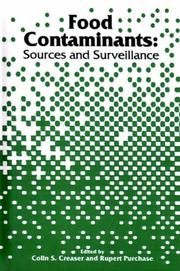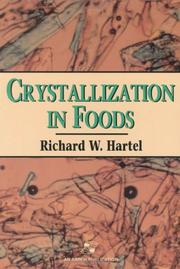| Listing 1 - 10 of 7975 | << page >> |
Sort by
|
Book
ISBN: 0857852337 0857852345 147258841X 9781472588418 9780857852342 9781336210653 1336210656 9781350042209 135004220X 9780857852328 0857852329 9780857852335 Year: 2014 Publisher: London New York
Abstract | Keywords | Export | Availability | Bookmark
 Loading...
Loading...Choose an application
- Reference Manager
- EndNote
- RefWorks (Direct export to RefWorks)
Food Waste is the first academic study to tackle this highly topical subject. Drawing from social science approaches to waste, material culture and everyday life in the home, the author uncovers the reasons behind the vast quantity of food wasted on a daily basis by households and consumers.
Book
ISBN: 1782847383 Year: 2022 Publisher: Eastbourne : Sussex Academic Press,
Abstract | Keywords | Export | Availability | Bookmark
 Loading...
Loading...Choose an application
- Reference Manager
- EndNote
- RefWorks (Direct export to RefWorks)
The food-secure and/or privileged worldwide no longer eat and drink simply to maintain life itself. They have the advantage and choice to regard "sustenance" not just as fuel for the body/machine but as a source of pleasure and entertainment for the mind/intellect. This enhanced concept of "sustenance" embraces all the senses: visual, auditory, olfactory, gustatory and tactile, thus including not just food & drink but ceremonies & art forms dealing with them. This book explores the substantive ways food & drink impact human existence. The work comprises five parts: medicine; ceremonies; literature & cinema; art & artists; space/architecture & advertising/art. Food & drink start with the physical, morph into nutrition, the most basic requirements for organic life, but progress from the beginning of physical process to ceremony and expression. The result and the experience highlight physiological and sensual concepts, and indeed, preference. Food & drink staples are determined by geographic availability and cuisine & beverage are closely associated with culture & ethnicity. Contributor exploration is wide-ranging: Aztec, Mexican & Spanish medicine; African & Roman Catholic rites; cookbook discourse and socio-gender influence; literature, including cultural comparisons of cooking and cooks; preparation & representation of food & drink as artistic endeavours, including by Latin American women, and types of inspirational "fodder", especially in the context of Picasso's art in Spain & France, & Spanish wine museums & labelling. Sustenance for the Body & Soul is the seventh book in the Hispanic Worlds series, details of which are available on the press website.
Book
ISBN: 0857854151 Year: 2012 Publisher: London, England : Berg,
Abstract | Keywords | Export | Availability | Bookmark
 Loading...
Loading...Choose an application
- Reference Manager
- EndNote
- RefWorks (Direct export to RefWorks)
TV cookery shows hosted by celebrity chefs. Meal prep kitchens. Online grocers and restaurant review sites. Competitive eating contests, carnivals and fairs, and junk food websites and blogs. What do all of them have in common? According to authors Kathleen LeBesco and Peter Naccarato, they each serve as productive sites for understanding the role of culinary capital in shaping individual and group identities in contemporary culture. Beyond providing sustenance, food and food practices play an important social role, offering status to individuals who conform to their culture's culinary norms a
Food --- Food consumption --- Food habits
Book
ISBN: 1071634135 1071634127 Year: 2023 Publisher: New York, NY : Springer US : Imprint: Humana,
Abstract | Keywords | Export | Availability | Bookmark
 Loading...
Loading...Choose an application
- Reference Manager
- EndNote
- RefWorks (Direct export to RefWorks)
This volume details well-established protocols and procedures being used by laboratories and the industry to study Predictive Microbiology in Foods. Chapters guide readers through methods to design and collect data to generate predictive models, the development of a predictive model, approaches the behavior mainly, and experiments in predictive microbiology. Written in the format of the Methods and Protocols in Food Science series, chapters list necessary materials and methods for readily reproducible protocols. Authoritative and cutting-edge, Predictive Food Microbiology aims to be a foundation for future studies and to be a source of inspiration for new investigations in the field. .
Book
ISBN: 3031354265 3031354257 Year: 2023 Publisher: Cham : Springer International Publishing : Imprint: Springer,
Abstract | Keywords | Export | Availability | Bookmark
 Loading...
Loading...Choose an application
- Reference Manager
- EndNote
- RefWorks (Direct export to RefWorks)
Cardamom [Elettaria cardamomum (L.) Maton is recognized for its unique taste and aroma. As the third most expensive spice after saffron and vanilla, Cardamom has been used as a spice and flavoring ingredient in food and is rich in bioactive constituents including minerals, carbohydrates, proteins, lipids, essential oils, terpenoids, flavonoids and carotenoids. Cardamom essential oil (CEO) and other bioactive compounds accumulated in cardamom capsules contribute to their characteristic aroma and utility as a novel food and nutraceutical. CEO from capsules possesses monoterpene constituents such as α-terpineol, 1,8-cineole, α-pinene, linalyl acetate, linalool, and nerolidol as well as the ester of α-terpinyl acetate. Flavonoids, anthocyanins, terpenoids, alkaloids, and other cardamom phenolics have shown high MIC values against Campylobacter species and reduced Bacillus subtilis spore. CEO loses its flavor rapidly upon storing under a normal environment. The change in the aroma or flavor could also cause changes in the constituents of its phytochemicals. Cardamom (Elettaria cardamomum): Production, Processing & Properties aims to create a multidisciplinary forum of discussion on E. cardamomum, emphasizing its botany, ethnobotanical, cultivation, horticultural practices, post-harvest, marketability, phytochemistry, extraction protocols, biochemistry, nutritional value, functionality, ethnomedicinal applications and and processing specifics. The book discusses the botanical distribution, phytochemical constituents, food applications and biological activities of cardamom capsule extracts and essential oil. Also, the text discusses the potential applications of E. cardamomum in food, cosmetics and pharmaceutical products. This book is the first of its kind, a full research work dedicated specifically to cardamom applications and benefits that will be of value for researchers from multiple fields. .
Book
ISBN: 908686368X 9086869203 9789086869206 Year: 2022 Publisher: Brill Academic Publishers
Abstract | Keywords | Export | Availability | Bookmark
 Loading...
Loading...Choose an application
- Reference Manager
- EndNote
- RefWorks (Direct export to RefWorks)
In Wat is eetbaar? laat Adel den Hartog zien hoe complex de voedselkeuzes van mensen al millennia lang zijn. Wie zich afvraagt waarom wij eten wat wij eten, komt uit bij praktische zaken als de beschikbaarheid van producten, transport en kosten, maar ziet ook fysiologische, culturele, geografische, en psychologische factoren. Den Hartog wijst op het belang van de toegang die individuen en groepen hebben tot voedsel, en van hun sociaaleconomische positie.Kan iemand worden overtuigd om iets te eten dat deze persoon als oneetbaar ziet? In het boek staan vele voorbeelden van onze geringe flexibiliteit, of die nu wordt ingegeven door een intolerantie met een genetische oorsprong, of doordat wat onbekend was, ook onbemind bleef. Voedingsgewoonten reageren traag op interventies, maar gebruiken kunnen veranderen. Zo is een vleesloze maaltijd tegenwoordig geen teken van armoede meer.Het boek zal de algemeen cultureel geïnteresseerde lezer aanspreken. Het is geschikt als handboek voor wie de achtergrond van onze eetgewoonten wil begrijpen. De kennis uit het boek is uitstekend te gebruiken bij een scala aan interventies op het gebied van voeding en leefstijl.
Food. --- Food habits.

ISBN: 9781845698287 1845698282 9781855737846 1855737841 Year: 2004 Publisher: Cambridge, England Woodhead Publishing
Abstract | Keywords | Export | Availability | Bookmark
 Loading...
Loading...Choose an application
- Reference Manager
- EndNote
- RefWorks (Direct export to RefWorks)
This book contains contributions based on the proceedings of two symposia on food contamination held in London in April 1989 and May 1990, both of which were organised jointly by the Environment, Food Chemistry and Toxicology Groups of the Royal Society of Chemistry. The aim of these meetings was to assess the extraneous chemical contamination of food from two sources: firstly, food-chain contaminants - the presence of plant toxicants of fungal metabolites in food, or the contamination of food from environmental sources (airborne, aquatic and terrestrial); and secondly, food-production contami
Food contamination. --- Food --- Toxicology.
Book
Year: 2023 Publisher: Basel : MDPI - Multidisciplinary Digital Publishing Institute,
Abstract | Keywords | Export | Availability | Bookmark
 Loading...
Loading...Choose an application
- Reference Manager
- EndNote
- RefWorks (Direct export to RefWorks)
The present reprint aimed to present original research articles and reviews concerning the following:Access: affordability, allocation, and preference of food;Availability: the production, distribution, and exchange of food;Circularity in food systems at local, regional, or global levels;The development, impact, and ethics of novel and data-driven technologies in food systems;Food security and policy, governance, institutions, and trade;Influencing food consumption and demand regarding the food environment;The stability and dynamics of food security aspects;Sustainable food systems and agro-ecological food production;Utilization: the nutritional value, social value, and safety of food.

ISBN: 0834216345 Year: 2001 Publisher: Gaithersburg Aspen
Abstract | Keywords | Export | Availability | Bookmark
 Loading...
Loading...Choose an application
- Reference Manager
- EndNote
- RefWorks (Direct export to RefWorks)
Crystallization --- Food --- Food texture
Book
Year: 2022 Publisher: London : IntechOpen,
Abstract | Keywords | Export | Availability | Bookmark
 Loading...
Loading...Choose an application
- Reference Manager
- EndNote
- RefWorks (Direct export to RefWorks)
Aflatoxins are produced by fungi on agricultural crops. They contaminate foods and feeds worldwide and are a threat to humans and animals. They can occur at any stage from pre- to post-harvest, including transportation and storage. This book discusses aflatoxins with chapters on occurrence and prevalence, contamination exposure, toxicology and control in foods and feeds, immunosuppressive actions, hazards and regulations, detection methods, effects of climate change, novel detoxification strategies, and legislations.
| Listing 1 - 10 of 7975 | << page >> |
Sort by
|

 Search
Search Feedback
Feedback About UniCat
About UniCat  Help
Help News
News